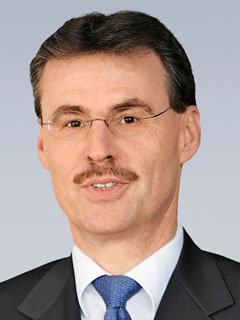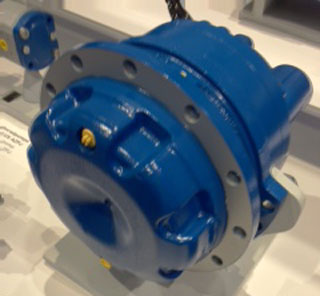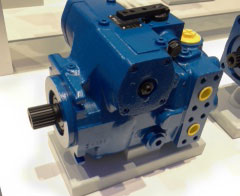
To gain perspective on the trends and innovations at this year’s Bauma fair, we had the opportunity to meet with Dr. Bertram Hoffmann, member of the executive board of Bosch Rexroth and president of the company’s business unit for mobile applications. Here are his views on trends in fluid power and mobile equipment, and how they relate to some innovative products announced at Bauma 2016.
“The construction equipment industry is currently focusing on three main topics,” said Hoffmann. One is new emission targets. Tier 4 final has only recently been implemented but new, stricter emission targets are on the horizon, coming into effect at the end of this decade.
The second major challenge is developing customized solutions for the wide-ranging markets and customer requirements around the globe.
“And finally, the third point is connectivity. Connectivity, in our opinion, is becoming a very important topic, and it is a prerequisite for integrated systems in the construction machinery market,” he said.
“The main key for mastering these three challenges is the ‘electronification’ of hydraulic systems in construction machinery,” said Hoffmann. Being part of the Robert Bosch Group offers a unique advantage not enjoyed by Rexroth competitors, he explained, because it can draw from a variety of technologies ranging from implement and travel-drive hydraulics to engine electronics. “So as a group, we are able to develop the perfect solution for each customer in different regions around the world,” he said.
Regarding emissions regulations, to meet those limits OEMs and their customers plan to embrace a host of measures to address that in the next few years. And to accomplish that, they need to increase energy efficiency. This is a challenging issue for manufacturers, and suppliers have been working on boosting efficiency for a number of years.
“The switch to the Tier 4 final standard in the U.S. market and Stage 4 standard in Europe has tied up a lot of resources. While this switch is largely completed now, the next step in emissions regulations will take effect in the U.S. and Europe in 2019,” Hoffmann said. “Today, our implement hydraulics and travel-drive hydraulics are already making a significant contribution to greatly reduce diesel consumption and exhaust emissions of construction machines. The crucial point here is that we do so while maintaining or even increasing performance and, very important for Rexroth, is to also increase the agility of these hydraulic systems.”
They’re accomplishing these goals by engineering systems that raise both hydraulic efficiency and power density, said Hoffmann.

“For example, the new radial-piston motor MCR-T offers significant benefits for travel-drive hydraulics used in compact tracked loaders, skid-steer loaders and other crawlers. Starting torque is 10% higher and provides more traction,” he explained. In addition, the MCR-T lets vehicles operate at high speeds while keeping the diesel motor’s rotational speed and fuel consumption low.
In another case, under current emission regulations the requirements for the diesel motor’s cooling capacity have been raised by up to 40%. “Hydrostatic fan drives by Rexroth provide this additional capacity on demand. But not only that, they also lower fuel consumption by up to 5%. These are only two examples. But as you can see, our solutions contribute significantly to our customers’ energy efficiency,” he stressed.
The second challenge relates to the types of components and service today’s OEMs and equipment users want, said Hoffmann. He noted that Rexroth engineers understand in the early stages of product development the customers’ requirements, “so we can customize products to suit different market needs of construction machines. On the one hand, customers want high-availability serial components of very good quality. On the other hand, they want individualized components, modules and overall solutions. In my opinion, Bosch Rexroth can offer both to our OEMs and end customers.
“For example, the axial piston variable pump A4VGT Series 34 with electronic proportional control is designed for use in drum drives in mobile concrete mixers,” said Hoffmann. “Customers can choose from three different nominal sizes to best meet their individual needs.”

In addition to specific components suited for typical applications, they have also developed “Design to Region” versions adapted to specific regional requirements—such as for China or India. “Let me give you an example. In China, the wheeled loader mid-segment—with which machinery manufacturers want to also enter into the export markets—is growing at a very fast rate. However, until now, most Chinese wheeled loaders in this category are still working with fixed-displacement pumps and open-center circuits.
“Their diesel consumption is higher, compared to solutions of European OEMs. Our answer is EDIS, the Energy Demand-oriented Implement System. It increases energy efficiency significantly and lowers diesel consumption by up to 10%. In this system, we are combining fixed and additional variable-displacement pumps with a priority valve for on-demand power generation. For the first wheeled loaders fitted with EDIS, the additional expense already paid for itself after just a few months,” said Hoffmann.
In addition, they’re working to upgrade the all-important area of service and maintenance. “The ability to repair construction equipment quickly and reliably across Europe is a key factor for ensuring minimal downtime for our customers and end users. Currently, we are qualifying independent workshops throughout Europe and developing a network of certified service points and repair centers. Operators of construction machinery can rely on these facilities having the necessary know-how, tool and testing equipment.”
Starting this summer Rexroth hydraulic pumps and motors can be ordered via the Internet around the clock, and the company’s central warehouse in Nurnberg has about 15,000 types of spare parts and 2.5 million components in stock, ensuring fast delivery and minimal customer downtime.
The model for high-quality and quick-turnaround repair and service in the U.S. will differ somewhat from that planned for Europe. But the goals are nonetheless the same when it comes to serving equipment users, he stressed.
Finally, there’s connectivity. “Connectivity, for Rexroth, is the topic of the future,” said Hoffmann. Here, they are concentrating on increasing the range of components and modules in the field that are particularly suited for new-generation maintenance programs. These modules fit the concept that construction machinery is equipped with intelligent components that record and transmit information on a machine’s operating status. To achieve this, they’re extending their range of sensors such as position, temperature and pressure and integrating them into hydraulic systems. “This creates the prerequisite for functional diagnostics and logging of measured data in our electronified drive solutions. Which, in turn, allows for state-dependent maintenance and thereby ensuring optimal machine availability,” he said.
“A good example for this is our new axial-piston variable pump A4VG Series 35. Using an open interface, it forwards previously recorded sensor data to the construction machine’s control unit. The control unit, in turn, is connected to the OEM’s cloud via Internet,” he said.
This is just one example of their capabilities, Hoffmann emphasized. The focus at Bosch Rexroth is on technical developments that constantly drive innovation forward in the area of intelligent connected construction machinery. They have been doing that for a number of years, and taking advantage of synergies with parent company, Robert Bosch Group.

